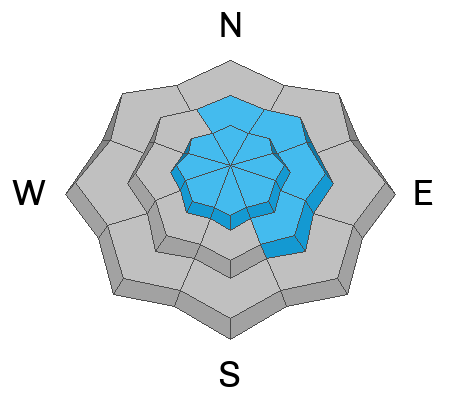Several inches of nice new snow refreshed the scenery and improved riding conditions significantly in the Central Bear River Range. It seems like similar amounts of snow accumulated in outlying areas, with about 6 inches of new snow showing at both the
Bloomington Canyon and the new
Card Canyon weather stations. The new snow smoothed in old tracks and caps a widespread melt-freeze crust from last week's warm spell at all elevations. Lower-angled sheltered slopes offer the best conditions because you blow through the new snow and scratch the crust in steeper terrain.
On upper and mid-elevation slopes steeper than 30°, people could trigger shallow wind slab avalanches of drifted new snow. These might run faster and further than expected on a stout melt-freeze crust from last week's warm spell.
The wind is blowing from the west this morning at 17 mph at the 9700' CSI Logan Peak weather station, and it's 13° F. On Paris Peak at 9500', it’s 12° F, and the wind is blowing 16 mph from the west-southwest.
The Tony Grove Snotel at 8400' reports 20° F and 5 inches of new snow in the last 24 hours. The station reports 77 inches of total snow, containing 116% of the average SWE (Snow Water Equivalent).
Today will start out with mostly cloudy skies, but clearing and sunny conditions are expected in the afternoon. High temperatures at 8500' are expected to be around 28° F, with a 10 mph wind blowing from the west becoming south in the afternoon.
Tonight, expect increasing clouds, temperatures, and winds blowing from the south. Snow will start falling after 11:00 and 2 to 4 inches of accumulation is possible on upper elevation slopes.
Snow is expected tomorrow, and it could be heavy at times, with 5 to 9 inches of accumulation possible above about 8000'. High temperatures around 33° F are expected, and strong and gusty winds will blow 25 to 40 mph from the south-southwest.
Snow will continue Monday night, with 3 to 5 inches of additional accumulation possible, low temperatures around 24° F, and winds coming around from the east.
Wintery weather, with snow and periods of heavy snow will continue through the upcoming week.
We received reports of a few shallow avalanches of heavy new snow in the northern part of the zone on Friday. A snowboarder triggered a 2" x 40' soft slab that ran into trees and piled up a couple feet deep, and skiers in Bloomington Canyon triggered a few sluffs running further than expected on the widespread melt-freeze crust. No avalanches were reported yesterday, but one party cracked a wind slab on a drifted northeast-facing slope at around 9000' in elevation.
Check out local observations and avalanches
HERE.











